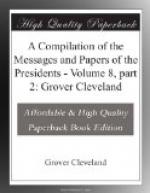Auxiliary to the same end, if it was not an essential part of the system itself, was the scheme, which at a later period obtained, for distributing the proceeds of the sales of the public lands among the States. Other expedients were devised to take money out of the Treasury and prevent its coming in from any other source than the protective tariff. The authors and supporters of the system were the advocates of the largest expenditures, whether for necessary or useful purposes or not, because the larger the expenditures the greater was the pretext for high taxes in the form of protective duties.
These several measures were sustained by popular names and plausible arguments, by which thousands were deluded. The bank was represented to be an indispensable fiscal agent for the Government; was to equalize exchanges and to regulate and furnish a sound currency, always and everywhere of uniform value. The protective tariff was to give employment to “American labor” at advanced prices; was to protect “home industry” and furnish a steady market for the farmer. Internal improvements were to bring trade into every neighborhood and enhance the value of every man’s property. The distribution of the land money was to enrich the States, finish their public works, plant schools throughout their borders, and relieve them from taxation. But the fact that for every dollar taken out of the Treasury for these objects a much larger sum was transferred from the pockets of the people to the favored classes was carefully concealed, as was also the tendency, if not the ultimate design, of the system to build up an aristocracy of wealth, to control the masses of society, and monopolize the political power of the country.
The several branches of this system were so intimately blended together that in their operation each sustained and strengthened the others. Their joint operation was to add new burthens of taxation and to encourage a largely increased and wasteful expenditure of public money. It was the interest of the bank that the revenue collected and the disbursements made by the Government should be large, because, being the depository of the public money, the larger the amount the greater would be the bank profits by its use. It was the interest of the favored classes, who were enriched by the protective tariff, to have the rates of that protection as high as possible, for the higher those rates the greater would be their advantage. It was the interest of the people of all those sections and localities who expected to be benefited by expenditures for internal improvements that the amount collected should be as large as possible, to the end that the sum disbursed might also be the larger. The States, being the beneficiaries in the distribution of the land money, had an interest in having the rates of tax imposed by the protective tariff large enough to yield a sufficient revenue from that source to meet the wants of the Government without disturbing




